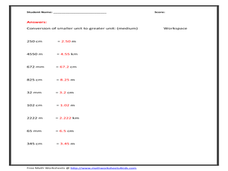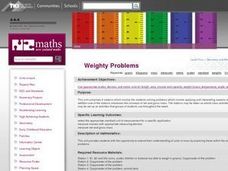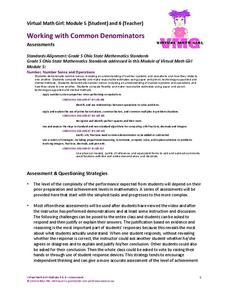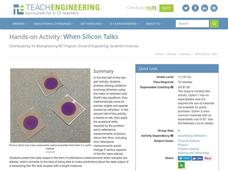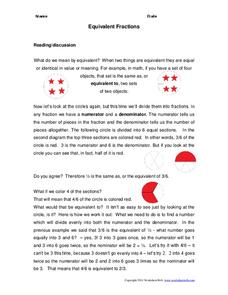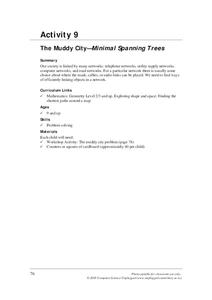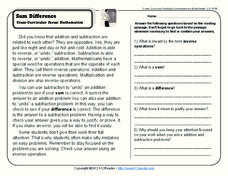Curated OER
Convert Cents into Nickels Level 1
In this counting coins worksheet, learners use their problem solving skills to convert 18 monetary amounts listed in cents to monetary amounts in nickels.
Curated OER
Standard Metric Units - Length
In this units of measure conversion worksheet, students use their problem solving skills to convert the 9 metric measurements listed to the assigned metric units.
Curated OER
Aggregate Demand and Supply Worksheet
In this economics activity, students use their problem solving skills to respond to 12 questions relating to aggregate supply and demand.
Curated OER
Squares Have Roots?
Young scholars define a square and connect this information to a square root. For this square root lesson, students make a chart listing square numbers and their roots.
Curated OER
Real Life Challenge
Students solve word problems using words and mathematical symbols. In this algebra lesson, students verbalize what they do to arrive at their answers. They set up their problems algebraically as they apply their knowledge of math to...
Curated OER
Addition and Subtraction of Whole Numbers
Fourth graders answer word problems based on the fifty states. In this math word problem lesson, 4th graders understand that differences in problems require different math operations.
Curated OER
First Amendment Rights
Fifth graders participate in a problem-solving and decision-making process involving the First Amendment rights to analyze and implement a solution for a school-related issue. They are given a variety of scenarios to apply the First...
Curated OER
Mass: Applying and Interpreting
Students rotate through six studying stations solving problems that involve applying and interpreting aspects of mass. They solve various word problems, and measure the contents of cans and calculate the mass of two cans.
Curated OER
Scott the Painter
In this algebra worksheet, students rewrite a word problem using algebraic symbols. They create a table to figure out what rooms should be painted first and in what order. There is an answer key to this problem.
Curated OER
Product + 1: Integers
In this integers activity, high schoolers solve 1 word problem using proof. Students prove their hypothesis of the result of multiplying four consecutive positive integers and adding one to the product.
PBS
Working with Common Denominators: Assessments
Now that the practice is over, see if young mathematicians can utilize their new skills on finding common denominators and adding fractions. The assessment contains one map challenge and follows with skills practice.
Education Development Center
Making Sense of Unusual Results
Collaboration is the key for this equation-solving lesson. Learners solve a multi-step linear equation that requires using the distributive property. Within collaborative groups, scholars discuss multiple methods and troubleshoot mistakes.
Curated OER
My Antonia: Problematic Situations
Introduce your class to the characters from My Antonia by Willa Cather in a unique way. Given a hypothetical situation about an atomic bomb shelter and a list of character descriptions, pupils must decide which characters get to...
EngageNY
Comparison Shopping—Unit Price and Related Measurement Conversions II
Which rate is greater and by how much? Pupils continue to compare rates to solve problems in the 20th portion of a 29-part series. Rates are presented in a variety of representations either using the same representation or different...
California Education Partners
Animals of Rhomaar
Investigate the growth rates of alien animals. Pupils study fictional animals from another planet to determine how much they grow per year. The investigators plot the growth of their animals over a period of time and then compare...
Teach Engineering
When Silicon Talks
Explore Snell's Law using thin films. In the fifth installment of a seven-part series, pupils solve a set of problems relating to Snell's Law and use this skill during an experiment requiring the collection of reflective measurements...
Worksheet Web
Equivalent Fractions
Learn how to identify equivalent fractions by using divisors. After reading and discussing the skill, young mathematicians solve two problems using visual fraction models, and then solve eight equivalent fraction problems...
National Security Agency
Are You Game? A Lesson Connecting Fractions and Probability
Exactly how fair are the board games children grow up playing? Young mathematicians investigate this questions as they work their way through this five-lesson series on basic probability.
Computer Science Unplugged
The Muddy City—Minimal Spanning Trees
What is the most efficient way to ensure everyone is connected? Individual pupils determine the least expensive route to pave roads in a fictional city. In doing so, they learn to find the minimal spanning tree for the situation. They...
Mathematics Vision Project
Module 3: Polynomial Functions
An informative module highlights eight polynomial concepts. Learners work with polynomial functions, expressions, and equations through graphing, simplifying, and solving.
K12 Reader
Sum Difference
If you need a way to address math and reading in one lesson, look no further than a passage about inverse operations, complete with reading comprehension questions. Kids focus on context clues to determine the meanings of unfamiliar words.
Personal Genetics Education Project
Engineering the World Around Us: Genome Editing and the Environment
Challenge young minds to build a better world with genetic engineering. Biologists learn potential solutions for environmental issues using genome editing while interacting with three case studies. Scholars read articles and view...
Dr. Seuss Enterprises
Read Across America
Celebrate the whimsical world of Dr. Seuss on Read Across America Day with a collection of science, technology, engineering, the arts, and mathematics activities, each linked to a popular Dr. Seuss story.
Education Development Center
Rational Exponents
It's rational to root for your class to learn about exponents. Scholars study rational exponents by reading a fictional dialogue between classmates. They analyze the conversation to understand the connection between rational exponents...

